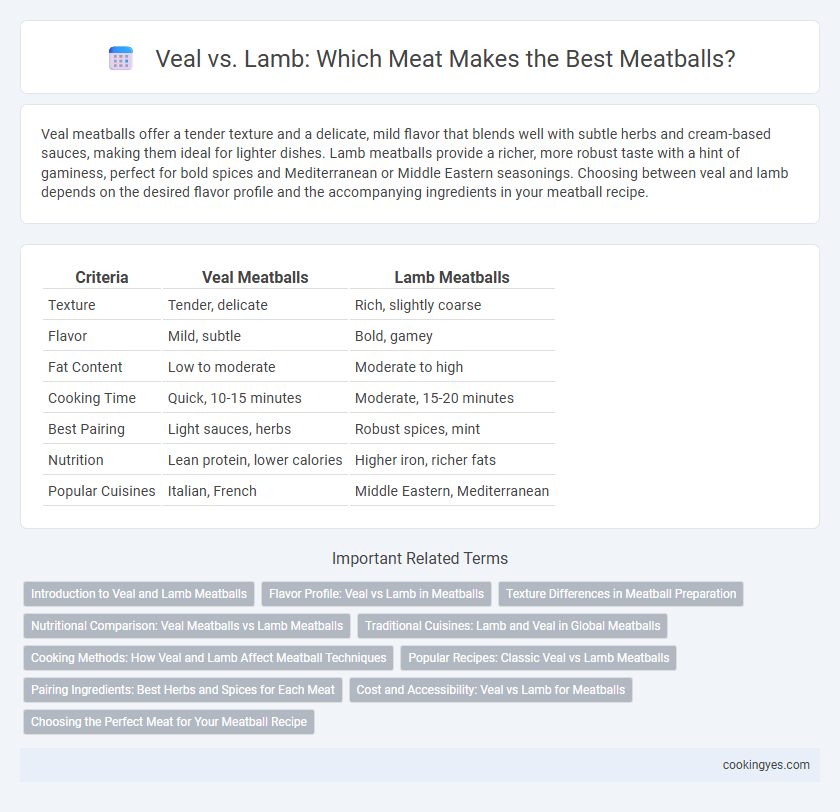Veal meatballs offer a tender texture and a delicate, mild flavor that blends well with subtle herbs and cream-based sauces, making them ideal for lighter dishes. Lamb meatballs provide a richer, more robust taste with a hint of gaminess, perfect for bold spices and Mediterranean or Middle Eastern seasonings. Choosing between veal and lamb depends on the desired flavor profile and the accompanying ingredients in your meatball recipe.
Table of Comparison
| Criteria | Veal Meatballs | Lamb Meatballs |
|---|---|---|
| Texture | Tender, delicate | Rich, slightly coarse |
| Flavor | Mild, subtle | Bold, gamey |
| Fat Content | Low to moderate | Moderate to high |
| Cooking Time | Quick, 10-15 minutes | Moderate, 15-20 minutes |
| Best Pairing | Light sauces, herbs | Robust spices, mint |
| Nutrition | Lean protein, lower calories | Higher iron, richer fats |
| Popular Cuisines | Italian, French | Middle Eastern, Mediterranean |
Introduction to Veal and Lamb Meatballs
Veal meatballs offer a tender, delicate flavor with a subtle sweetness, making them ideal for gourmet recipes seeking a refined taste. Lamb meatballs provide a richer, earthy profile with robust seasoning potential, often paired with Mediterranean and Middle Eastern spices. Both veal and lamb serve as versatile bases that elevate traditional meatball dishes through unique texture and flavor nuances.
Flavor Profile: Veal vs Lamb in Meatballs
Veal meatballs offer a delicate, mild flavor with a tender texture that absorbs herbs and spices well, creating a subtle, refined taste. Lamb meatballs present a robust, earthy flavor with a slightly gamey undertone, lending richness and depth to the dish. The choice between veal and lamb significantly impacts the overall flavor profile, with veal providing lightness while lamb delivers boldness.
Texture Differences in Meatball Preparation
Veal meatballs feature a delicate and tender texture due to the fine grain and lower fat content of veal, resulting in a softer bite that absorbs flavors well. In contrast, lamb meatballs possess a coarser, slightly fattier texture that offers a richer, more robust mouthfeel and a pronounced savory taste. The choice between veal and lamb significantly impacts meatball preparation, influencing moisture retention and the overall sensory experience of the dish.
Nutritional Comparison: Veal Meatballs vs Lamb Meatballs
Veal meatballs provide a leaner protein source with lower fat and calorie content compared to lamb meatballs, making them suitable for those seeking a lighter option. Lamb meatballs are richer in omega-3 fatty acids and higher in iron and zinc, contributing to better cardiovascular and immune health. Both meats offer distinct nutritional benefits, with veal favoring lower saturated fats and lamb providing more essential minerals and healthy fats.
Traditional Cuisines: Lamb and Veal in Global Meatballs
Lamb meatballs are a staple in Middle Eastern and Mediterranean cuisines, prized for their rich, gamey flavor that pairs well with spices like cumin, coriander, and mint. Veal meatballs, prominent in Italian and French cooking, offer a tender texture and mild taste that absorbs herbs such as rosemary, sage, and garlic. Both meats provide distinctive regional variations, with lamb emphasizing robust, aromatic profiles and veal delivering delicate, subtly flavored meatballs ideal for creamy sauces and light broths.
Cooking Methods: How Veal and Lamb Affect Meatball Techniques
Veal meatballs require gentle cooking methods like simmering or baking to maintain their tender texture, as the lean meat can dry out easily. Lamb meatballs benefit from grilling or pan-frying, which enhances their rich, fatty flavor and helps develop a crispy exterior. Adjusting cooking techniques based on the meat type ensures optimal moisture retention and flavor complexity in meatball variations.
Popular Recipes: Classic Veal vs Lamb Meatballs
Classic veal meatballs offer a tender, mild flavor that pairs well with creamy sauces like bechamel or light tomato-based options, making them a staple in Italian-American cuisine. In contrast, lamb meatballs boast a richer, gamey taste accented by herbs such as rosemary and mint, commonly found in Mediterranean and Middle Eastern recipes. Popular dishes like Italian-style veal meatballs highlight delicate spices and soft textures, while lamb meatballs shine in spiced blends with cumin and garlic, providing a robust alternative for meatball variations.
Pairing Ingredients: Best Herbs and Spices for Each Meat
Veal meatballs pair exceptionally well with delicate herbs like sage, thyme, and rosemary, which enhance their mild and tender flavor without overpowering it. Lamb meatballs benefit from robust spices such as cumin, coriander, and mint, complementing their rich and slightly gamy profile with aromatic warmth and freshness. Both variations can be elevated with garlic and onion, but the key to distinguishing their taste lies in selecting herbs and spices that harmonize with the unique character of each meat.
Cost and Accessibility: Veal vs Lamb for Meatballs
Veal meatballs tend to be more expensive due to the higher cost of veal production and limited availability compared to lamb. Lamb is generally more accessible in various markets, offering a cost-effective option for meatball recipes without compromising flavor. Choosing between veal and lamb depends on budget considerations and local meat availability for consistent supply.
Choosing the Perfect Meat for Your Meatball Recipe
Veal offers a tender texture and subtle flavor ideal for delicate, smooth meatballs, while lamb provides a richer, gamey taste that adds depth and robust character. Selecting veal results in lighter, melt-in-the-mouth meatballs suited for refined dishes, whereas lamb enhances recipes with bold seasoning and a distinctive aroma. Understanding these flavor profiles helps tailor your meatball variation to achieve the perfect balance between tenderness and intensity.
Veal vs Lamb for meatball variation Infographic

 cookingyes.com
cookingyes.com